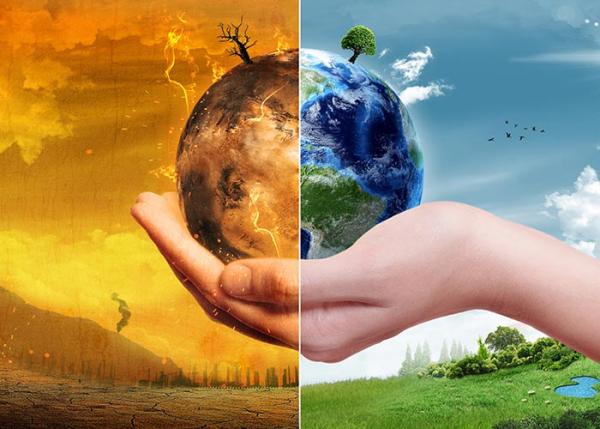Bangladesh, for example, will face increasing water levels and natural disasters like cyclones that it is unprepared to deal with. According to one estimate, by 2020, Bangladesh will face a 50 percent reduction in rain-fed agriculture. South Asia, by 2020, will face an estimated 10 percent drop in staple crops like rice and maize. Countries like Pakistan could face 50 percent reduction in these staples by 2020. The impact on food security in Bangladesh and other countries will be catastrophic if estimates hold.

Climate change: Bangladesh at risk!
AKM Ahihab
A World Bank report released a few months ago, “Shock Waves: Managing the Impact of Climate Change on Poverty,” predicts that global warming will push 100 million more people into extreme poverty over the next decade and a half. This means that 100 million more people will see their incomes drop to under 1.90 dollars per day. This would add a hundred million to the roughly 700 million people earning 1.90 dollars a day or less, or what the World Bank defines as “extreme poverty.”
The people of the poorest countries are the most threatened, especially the people of Sub-Saharan Africa and South Asia. According to the report, climate change will have terrible consequences for agriculture and health of the poor parts of the world. Crop yields will be reduced by five percent by 2030. This will cause food costs to rise for the poorest people. Natural disasters, like flooding, will become more frequent. And diseases will become more widespread among the poorest parts of the world.
It should also be emphasized that global warming is potentially catastrophic in some cases. For example, of major countries, Bangladesh is ranked the most vulnerable to global warming. By 2020, an estimated 500 to 750 million, mostly in the poorer countries, will be affected by water stress caused by climate change. Low-lying coastal countries such as Bangladesh are especially threatened.
Bangladesh, for example, will face increasing water levels and natural disasters like cyclones that it is unprepared to deal with. According to one estimate, by 2020, Bangladesh will face a 50 percent reduction in rain-fed agriculture. South Asia, by 2020, will face an estimated 10 percent drop in staple crops like rice and maize. Countries like Pakistan could face 50 percent reduction in these staples by 2020. The impact on food security in Bangladesh and other countries will be catastrophic if estimates hold.
Global climate change, especially global warming, is potentially so threatening that even the capitalists at the World Bank and other global institutions taken notice. So much is global warming a threat to the entire capitalist system that it cannot be ignored. However, the managers of Empire are unable to address the problem in a serious way because to do so would require a revolutionary change in the global class structure. The global economy is organized in such a way that the poorest countries suffer the worst effects of capitalist production. The populations of the poorest countries slave away for subsistence or sub subsistence wages producing commodities that they themselves rarely consume.
The populations of the poorest countries suffer the toxic environments and natural disasters that are a result of capitalist production. At the same time, it is the wealthy countries that reap the benefits of the modern consumer culture. The populations of the wealthy countries live in relative comfort and stability.
Interestingly, a recent poll showed that concern about climate change reflects the global class structure. The poorer countries, with Africa and Latin America leading the pack, say climate change is of “grave concern.” By contrast, even though climate change is recognize as a real problem by international institutions of Empire, less than half of the people polled in the United States see climate change as a serious problem.
In the Communist Manifesto, Karl Marx famously stated:
“The history of all hitherto existing society is the history of class struggles.
Freeman and slave, patrician and plebeian, lord and serf, guild-master and journeyman, in a word, oppressor and oppressed, stood in constant opposition to one another, carried on an uninterrupted, now hidden, now open fight, a fight that each time ended, either in a revolutionary reconstitution of society at large, or in the common ruin of the contending classes.”
It is often forgotten that Marx did not see revolution as the only consequence of class struggle. There is another possibility: our common ruin. This is the reality that humanity faces. Global capitalism is pushing our planet, our common home, to its limits. The capitalist world’s culture of consumption and waste is pushing the environment to a breaking point. The majority of humanity, the global poor, the proletariat suffers. A minority, the global rich, the bourgeoisie consume more and more, waste more and more. If we are to avoid our common ruin, if there is to be a future for our children and their children, we must awaken. We are the vast majority. According to Bakunin the working class is not the central agent of revolution. He considered peasants and the urban unemployed, beggars, petty criminals, etc. to be much more potent revolutionary forces. His repeated declaration that the first step in any revolution should be to have "all legal papers consigned to the flames", and all public regulation of debts and taxes abolished, was designed to appeal to the peasant for whom "the state" is nothing but the unwelcome tax-collector.
We are the only ones who can stop this madness. Time is running out. Now is the time to organize people, educate people, and raise the banner of the Global movement of Anarcho-syndicalism and ‘stateless democratic confederation’, Ruin or revolution?






Comments